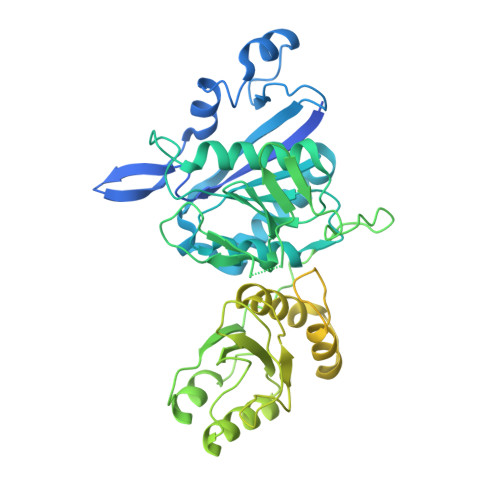Experimental Data in Support of a Direct Displacement Mechanism for Type I/II l-Asparaginases.
Schalk, A.M., Antansijevic, A., Caffrey, M., Lavie, A.(2016) J Biol Chem 291: 5088-5100
- PubMed: 26733195
- DOI: https://doi.org/10.1074/jbc.M115.699884
- Primary Citation of Related Structures:
5DNC, 5DND, 5DNE - PubMed Abstract:
Bacterial L-asparaginases play an important role in the treatment of certain types of blood cancers. We are exploring the guinea pig L-asparaginase (gpASNase1) as a potential replacement of the immunogenic bacterial enzymes. The exact mechanism used by L-asparaginases to catalyze the hydrolysis of asparagine into aspartic acid and ammonia has been recently put into question. Earlier experimental data suggested that the reaction proceeds via a covalent intermediate using a ping-pong mechanism, whereas recent computational work advocates the direct displacement of the amine by an activated water. To shed light on this controversy, we generated gpASNase1 mutants of conserved active site residues (T19A, T116A, T19A/T116A, K188M, and Y308F) suspected to play a role in hydrolysis. Using x-ray crystallography, we determined the crystal structures of the T19A, T116A, and K188M mutants soaked in asparagine. We also characterized their steady-state kinetic properties and analyzed the conversion of asparagine to aspartate using NMR. Our structures reveal bound asparagine in the active site that has unambiguously not formed a covalent intermediate. Kinetic and NMR assays detect significant residual activity for all of the mutants. Furthermore, no burst of ammonia production was observed that would indicate covalent intermediate formation and the presence of a ping-pong mechanism. Hence, despite using a variety of techniques, we were unable to obtain experimental evidence that would support the formation of a covalent intermediate. Consequently, our observations support a direct displacement rather than a ping-pong mechanism for l-asparaginases.
Organizational Affiliation:
From the Department of Biochemistry and Molecular Genetics, University of Illinois at Chicago, Chicago, Illinois 60607 and.
















